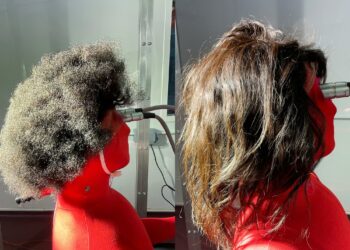Specific types of stem cells have the capacity to move between growth compartments within hair follicles. However, as people age, these cells become trapped and are unable to mature and sustain hair color, resulting in their loss of function, a new study found. This could be the mechanism for hair turning gray, the researchers said.

Led by a team at New York University, the study focused on cells in the skin of mice that are also found in humans called melanocyte stem cells, or McSCs. The pigmentation of hair is determined by the maturation of multiplying pools of McSCs within hair follicles, which produce protein pigments that give hair its color upon receiving the right signal.
“Our study adds to our basic understanding of how melanocyte stem cells work to color hair,” study author Qi Sun said in a statement. “The newfound mechanisms raise the possibility that the same fixed-positioning of melanocyte stem cells may exist in humans. If so, it presents a potential pathway for reversing or preventing the graying of human hair.”
Why is our hair turning gray?
In their study, the researchers used 3D imaging and single-cell RNA sequencing to follow the movement of McSC cells in mice as they aged within hair follicles. Their findings showed that these cells show remarkable plasticity while transitioning between compartments of the hair follicle during normal hair growth.
It is within these compartments that McSCs encounter various protein signals that influence their maturation. In their work with mice, the researchers discovered that McSCs can transition between their most primitive stem cell state and the next stage of maturation, known as the transit-amplifying state, depending on their location in the follicle.
“It is the loss of chameleon-like function in melanocyte stem cells that may be responsible for graying and loss of hair color,” study senior investigator Mayumi Ito, a professor of dermatology, said in a statement. “These findings suggest that melanocyte stem cell motility and reversible differentiation are key to keeping hair healthy and colored.”
As hair ages, falls out, and regenerates, an increasing number of McSCs become trapped in the stem cell compartment located within the hair follicle called the bulge. When this happens, they can’t mature into the transit-amplifying state or return to their original location. This process is associated with graying hair, the researchers explained.
During their experiments, the researchers observed that physically aging the hair of mice by plucking and forced regrowth caused the number of hair follicles with McSCs stuck in the bulge to increase from 15% prior to plucking to nearly 50% post-ageing. These cells could not regenerate or mature into melanocytes responsible for producing pigment.
The study showed that the McSCs from the mice that were trapped in the bulge lost their regenerative capacity. In contrast, other McSCs that instead continued to migrate between the follicle bulge and hair germ retained their ability to regenerate, producing pigment consistently over the two-year study period.
Leila Asfour, an expert from the British Association of Dermatologists, told the BBC that the “obvious implication” of the research is that we could be one step closer to reversing our gray hairs. The study could also help us to better understand other conditions where the stem cells could play a role, such as the deadly skin cancer called melanoma, she said.
The study was published in the journal Nature.






